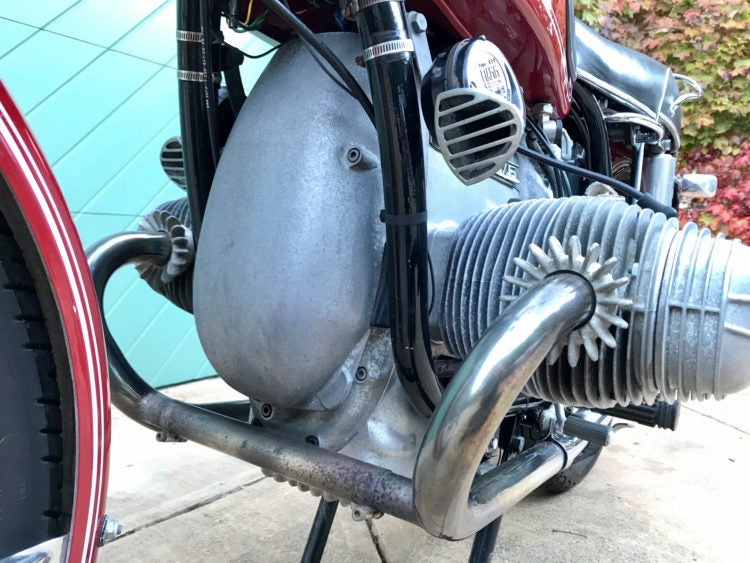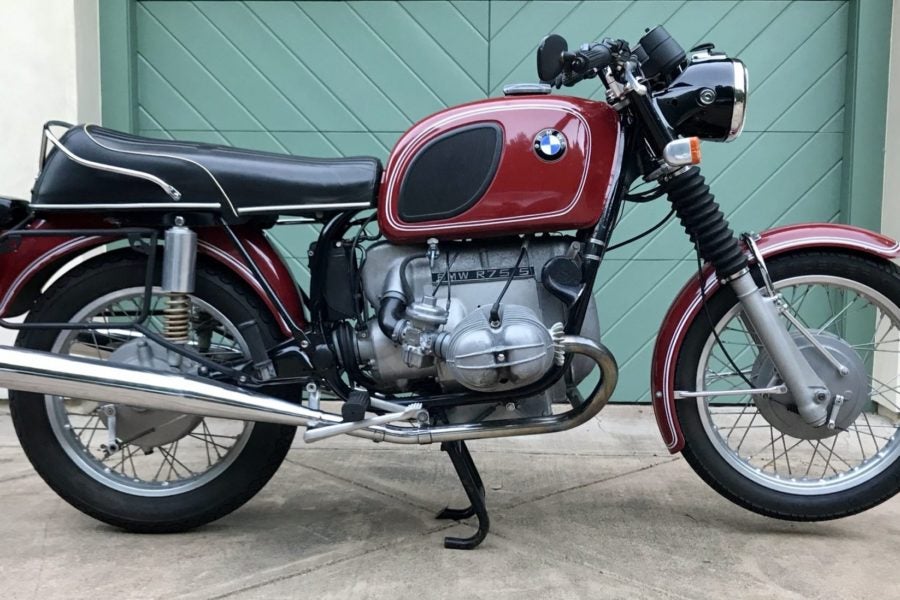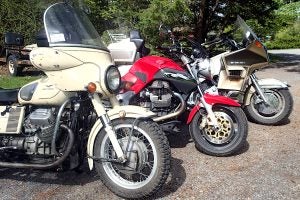It’s tough if you want to buy a decent used bike and actually ride it. If you find something in really good shape, you’re often facing astronomical prices these days. If you buy a fixer-upper, you can end up spending more time wrenching than riding, and with current supply chain weakness, do you really want to be searching for parts these days?
So, if you’re looking to ride, it’s great to find a machine with a bit of honest wear, something that you can have in top running order with a day’s fettling. A machine with a reputation for reliability, and a generally solid parts supply. A machine like this 1973 BMW R75/5.

That flat twin engine is similar to the /2, but with lots of smaller upgrades that add up to a much better overall package.
Euro Trash Treasure
BMW was in an interesting position in the 1970s. The Japanese manufacturers were hammering the established Euro marques, building faster, more affordable, more reliable bikes. And yet BMW hung on, while so many other brands failed. Why? A lot of that success was due to BMW’s /5 series from the start of the decade.
As you’d expect, the R75/5 had a 750cc engine (there was also a 500cc and 600cc machine in the /5 lineup). It was BMW’s big-bore mileburner, using principles that had served the company well for decades. An air-cooled, two-valve flat twin was the heart of the bike. The 750 engine made around 50 horsepower. That’s a bit behind the hottest offerings from Honda and Kawasaki in those days, but the Beemer had decades of sober reliability backing it up. The /5 engines were all obvious descendants of the previous /2 series but had some little tweaks that all added up to decent improvement over the previous generation. The internal oiling system was updated, with upgraded bearings for increased longevity. The chain-driven camshaft was relocated (the /2 had a gear-driven camshaft), allowing more ground clearance. More importantly, a modern 12-volt charging system (with three-phase 180-watt alternator) brought the bike’s electrical bits up to date. There was an electric starter as standard, although all /5 models also had a kickstarter.

Looks like that right cylinder’s seen some adventure at some point.
The BMW R75/5 came with 32mm Bing CV carbs as standard. Like all airheads, the R75/5 had a shaft drive. A one-plate dry clutch came as standard, and four-speed gearbox.
BMW also cut a fair bit of weight on the /5 series, thanks to plastic fenders and other measures. The chassis itself was lighter, and the R75/5 had telescopic forks, instead of the heftier Earles fork used on the /2 series (dual rear shocks were standard, of course). Wet weight was supposedly 210 kilos, or 463 pounds, which certainly isn’t outrageous when compared to the competition of its era. More importantly, that weight handled well; the R75/5 was supposedly good for almost 110 mph, and it was supposed to be a stable machine at that speed.

A classic airhead look.
Looking at the Bring a Trailer advert, you can see the /5 models had drum brakes front and rear—yuck. BMW moved to proper disc brakes on the /6 series, and also upgraded the electrics with a beefier charging system and other improvements. Just as this machine was an evolutionary step over the previous model, the next /6 series has some decent upgrades over the /5 models.
And, that’s how BMW stayed alive in the ’70s. It didn’t stake its future on a failed plan to re-invent itself, and it didn’t spend years circling the drain like the Brit manufacturers, refusing to innovate. BMW built solid machines, gave them sensible upgrades every few years, and that was enough to keep faithful customers happy.

There are a few aftermarket add-ons, but nothing too serious. The exhaust would be the most noticeable, and that’s replaceable if you don’t like it.
Sensible Retro
This ’73 model would have been built towards the end of /5 production, as BMW moved to the /6 for 1974. It looks used, but not abused. The ad says it was “purchased new by the seller’s brother at BMW of Marin, California before spending time with his other brother in Wyoming, and was acquired by the seller in 1978.” It sounds as if the bike’s been sitting basically unused for decades, with only 200 miles since a 1996 engine rebuild (new oversized pistons, transmission input shaft, clutch, MCM aftermarket exhaust and petcocks).
There’s some obvious corrosion on the engine, trim, rear suspension and exhaust, but nothing shocking, considering it’s almost 50 years old, with 33,000 miles on the odometer. And if you want a machine for a runner, a few imperfections aren’t the end of the world; after all, these bikes were made to be used, not ogled.

There is a fair bit of corrosion. It doesn’t look serious, but it does look a tad ugly. That might steer buyers away from what looks like a solid vintage bike.
If you buy it, there’s some stuff to sort out. The ad says you’ll want new tires, as the current rubber was installed in 2000. Also, the electric start doesn’t work. That’s not the end of the world, as the kickstarter will get you going, but you’ll probably want to fix that. According to the ad, “An oil change and battery replacement were carried out in preparation for the sale. The seller states that the cylinder heads should be re-torqued, a starter issue diagnosed, and the remainder of the fluids changed before the bike is ridden.”
If you’re into airheads, or if you’re generally mechanically adept, none of that sounds too scary. At time of writing, the asking price is a $2,500. No doubt that will climb as the auction approaches its end on Monday, January 11, but as long as it’s not too much more, this could be a great chance for a reliable vintage bike at a sensible price. It might look just a tad rough around the edges, but that shouldn’t stop it from pounding out the miles.
Photos: Bring a Trailer







